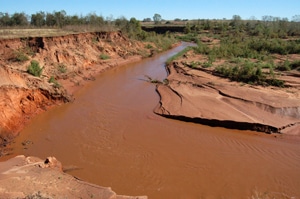Cooperative Conservation Partnership Initiative Will Help Repair Storm Damage in Southwest Oklahoma

A new Cooperative Conservation Partnership Initiative (CCPI) for Oklahoma has received federal approval, the Oklahoma Conservation Commission (OCC) has announced. Chief Dave White, USDA Natural Resources Conservation Service (NRCS), has approved the project for the reconstruction of conservation and flood control infrastructure in the Sugar Creek Watershed in Caddo County in southwestern Oklahoma. The infrastructure was severely damaged by storm and flooding events in August 2007 when Tropical Depression Erin ravaged the western part of the state.
The project will bring $99,943 of federal funding to Oklahoma in the first year of the project and a five-year commitment of just under $2 million to be combined with state matching funds and in-kind matches of labor, materials and use of equipment.
Nationally, USDA is providing nearly $7 million in financial assistance in the fiscal year 2010 through CCPI, administered by NRCS. CCPI works through three existing programs — the Environmental Quality Incentives Program (EQIP), the Conservation Stewardship Program (CSP) and the Wildlife Incentives Program (WHIP) — to leverage additional services and resources from non-federal partners.
The partners involved in the project along with the OCC are the South Caddo Conservation District, North Caddo Conservation District, Caddo County Board of Commissioners and the Oklahoma branch of NRCS.
The expected benefits of this project will be to stabilize and protect 3,700 acres of prime farmland in the Sugar Creek watershed floodplain, stabilize the channels that are eroding their way toward numerous flood control structures in the watershed, and improve the water quality in Sugar Creek by reducing sedimentation and associated nutrient loads. This work will be done on privately-owned land with producers who all have long histories of cooperating with their local Conservation District and the NRCS to implement best management practices (BMPs) on their lands. Approximately one-fourth of the project area is tribal allotted land.
The Sugar Creek Watershed drains approximately 230 square miles of Caddo County, Oklahoma into the Washita River. Beginning in the late 1950s, the Soil Conservation Service initiated intensive efforts to increase agricultural production through flood mitigation. The watershed experienced a 500-year storm event in August 2007 which resulted in catastrophic floods causing millions of dollars in damages to homes, crops, agricultural lands, and conservation infrastructure. Following the storm, the Oklahoma Conservation Commission, associated conservation districts, and local NRCS personnel have committed significant resources to damage assessment and strategic planning to repair flood-ravaged farmland and conservation infrastructure. The proposed CCPI is a critical component of a multi-pronged strategy to leverage the resources necessary to accomplish these goals.
“Although some of the flood-damaged area is to be repaired and reconstructed with funds from a Federal Emergency Management Agency (FEMA) grant, many areas that desperately need conservation work do not qualify for FEMA assistance,” said Ron Hilliard, USDA NRCS state conservationist for Oklahoma. This cooperative partnership program will potentially provide over $3 million in state and federal funds through the CCPI over a five-year period to provide cost-share to producers for conservation practices necessary to mitigate channel instability threatening the watershed’s extensive flood structure network.
Partnership efforts would contribute $491,850 in non-Federal funds through technical and administrative support for local project delivery as well as $539,378 in state funds to provide producer match for EQIP. Some of the practices planned are constructing grade stabilization structures, shaping and filling gullies and planting vegetation in critical areas.
OCC is able to provide the necessary state match to receive the federal funding because a bond passed by the state Legislature in 2009 specifically to fund conservation and flood control-related efforts.
“The conservation bond was essential in allowing OCC to secure this CCPI program,” said Mike Thralls, executive director of the Oklahoma Conservation Commission, “and offer the opportunity for significant beneficial environmental, social and economic benefits in the Sugar Creek Watershed.”
OCC will also incorporate its Blue Thumb volunteer water quality monitoring program into the Sugar Creek CCPI program, Thralls said. In addition to water quality monitoring, the Blue Thumb program will provide community outreach and education, he said.
